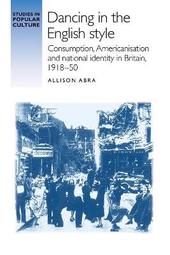
|
Dancing in the English Style: Consumption, Americanisation and National Identity in Britain, 1918-50
Paperback / softback
Main Details
| Title |
Dancing in the English Style: Consumption, Americanisation and National Identity in Britain, 1918-50
|
| Authors and Contributors |
By (author) Allison Abra
|
| Series | Studies in Popular Culture |
|---|
| Physical Properties |
| Format:Paperback / softback | | Pages:304 | | Dimensions(mm): Height 234,Width 156 |
|
| Category/Genre | Dance
British and Irish History |
|---|
| ISBN/Barcode |
9781526142627
|
| Classifications | Dewey:793.30941 |
|---|
| Audience | |
|---|
| Illustrations |
7 black & white illustrations
|
|
Publishing Details |
| Publisher |
Manchester University Press
|
| Imprint |
Manchester University Press
|
| Publication Date |
26 September 2019 |
| Publication Country |
United Kingdom
|
Description
This book illuminates the history of popular dance, one of the most influential and widespread leisure practices in early twentieth-century Britain. It focuses on the relationship between dancing and national identity construction, in a period when Britain participated in increasingly global markets of cultural production, consumption and exchange. -- .
Author Biography
Allison Abra is Assistant Professor of History and a Fellow in the Dale Center for the Study of War & Society at the University of Southern Mississippi -- .
Reviews'[...] this nuanced and well-researched study demonstrates the merits of using popular dance as a gateway into British social and cultural history.' Laura Quinton, New York University, Twentieth Century British History, 2018 'Drawing upon a fascinating range of source material (including autobiographies, Mass Observation, and the trade press), she tackles a series of complex issues, and advances a number of intriguing, important, and convincing arguments.' Canadian Journal of History 'Dancing in the English Style breaks new ground in many areas [...and] is a detailed, well-written, and comprehensive account of its subject.' Journal of British Studies 'The book's value lies in its emphasis on the commercialization of dance during the period and its connection to national identity - something hitherto not explored in any real depth. These discussions of national identity and its link to commercialism will interest scholars from a wide variety of fields, and hopefully serve to spark different perspectives on this under-researched area. The book therefore serves as vital reading for scholars of dance and twentieth-century Britain more broadly, but also those interested the variety of ways national identity can be constructed and performed.' Journal of Contemporary History -- .
|